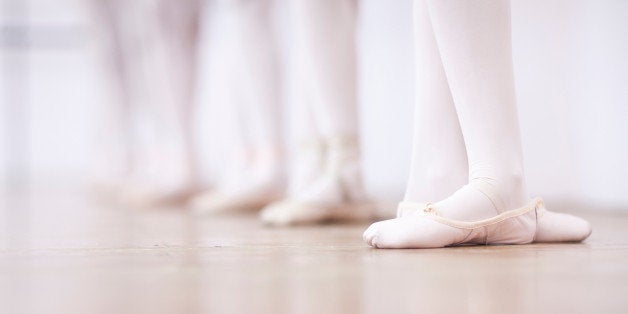
I saw another one of those ads today on the side of my browser, trying to sell me another one of those ballet-themed workout classes. It had all the usual features: a picture of a young, lean female instructor, a reference to Black Swan, a statement about toned butts, and of course, the promise of "looking" (not moving, feeling, or being) like a dancer. Of course, this workout would not contain any ballet technique and certainly no actual dancing.
As a lifelong dancer, I am disheartened by such commercial movements, which have managed to strip the dancing out of dance. But even more importantly, I see this "barre workout" trend as a symptom of a culture that teaches people -- especially women -- to have a relationship with their bodies only from the outside -- how they appear to others -- while ignoring the internal experience of movement.
I am reminded of art critic John Berger's statement about subjects in both paintings and life: "Men act and women appear." Women cannot act without being constantly aware of how they appear to an outside surveyor. While I certainly wouldn't say that men's fitness ignores appearance, we can clearly see that this female-targeted fitness movement -- specifically claiming to make one appear as a dancer without acting as one -- plays into the notion that women's bodies matter only for form, not function.
Sometimes, I'm actually surprised by how most people have such a limited view of the purpose of movement and bodies. When I tell people that I am a dance major or that I dance 25 hours a week, a common response is, "Wow, that must be really good exercise."
Exercise -- I have to keep myself from laughing. As dancers, we spend years internalizing the nuances of technique, learning volumes of choreography, engaging in creative processes, honing artistry, and learning how to become fearless and emotionally exposed onstage.
Saying that dancing is good for exercise is like saying computer programming is good for practicing typing skills: Sure, that happens, but that's hardly the main point.
And while I would love for more people to appreciate the artistry of professional concert dance, just as important is the role that dance can have in the lives of non-professionals who don't even consider themselves "dancers." Dance has been used throughout history as a mode of cultural bonding, religious experiencing, courtship, storytelling, and just plain fun. So why should we erase that all from our lives to focus exclusively on perky butts?
In fact, I'm a little skeptical of the whole concept of "exercise" as we currently understand it, the act of moving the body as isolated from the rest of our life experiences. Movement is neatly confined to a scheduled hour in the day, chosen specifically for a particular aesthetic end, and divorced as much as possible from any intellectual or emotional activity. Perhaps it's a symptom of that pesky Cartesian mind-body duality that we keep clinging to: You can be a body for an hour and then go back to being a mind for the rest of your life, but the two shouldn't overlap.
Much is at stake with our conception of bodies and movement. A lot has been said about how beauty ideals, such as the ones sold in these fitness adds, impacts self-esteem and mental health -- and with good reason: Statistics published by the National Association of Anorexia Nervosa and Associated Disorders said 91 percent of surveyed college women had attempted dieting and 35 percent of "normal dieters" eventually engage in pathological dieting.
However, even popular body image movements (think Dove's "Real Beauty" campaign) enforce the idea of understanding and appreciating the body from the outside, telling women that they do indeed appear "beautiful." But what if we started appreciating our bodies for doing, feeling and being instead of just looking?
Dance training isn't always associated with body positivity, but it does show you a lot of ways to understand and appreciate your body that are unrelated to looks. I love my body because it allows me to fly through a 20-minute piece of intense jumping. I love my body because of the range of improvisational possibilities it unlocks. I love my body because of the pleasure I get from sending it through a stream of fluid contemporary choreography. In fact, I love my body because it allows me to get up in the morning and walk and see and hear and breathe.
If you want to take that barre workout class, go ahead. But trust me, if you take the chance to really internally experience movement in your body outside of those 60 minutes of leg lifts -- whether it be taking a beginning ballet class, dancing naked in your bedroom, or just taking a moment to notice the sensation of your muscles sliding across your bones, your skin stroking your muscles, as you roll out of bed in the morning -- it will be worth it.
If you're struggling with an eating disorder, call the National Eating Disorder Association hotline at 1-800-931-2237.